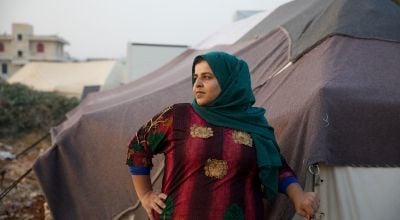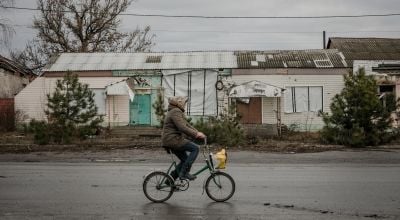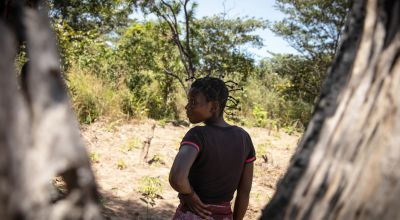
Read our 2022 annual report

Knowledge Hub
Here's what you need to know about some of the world’s worst humanitarian crises in 2024.
At the end of 2019, we presented 5 of the worst humanitarian crises to know in 2020 - just before the onset of one of the world’s largest humanitarian crises in recent history.
Since then, our annual ranking of humanitarian crises (which in itself is a tricky term, more on that below) has reflected the difficulties added by COVID-19, as well as protracted conflict, climate change, and other factors that have led to a record number of complex humanitarian emergencies.
“Ranking” humanitarian crises isn’t as easy or as straightforward as the title makes it seem. We’re basing this list on figures provided by UNOCHA’s 2024 Global Humanitarian Overview, which factors in the number of people in need of assistance, funding needed to meet that need, and the level of funding met for the year ahead. Some numbers represent a combination of need based on the UN’s estimates, which in some cases are separated by humanitarian need and refugee need.
What is a humanitarian crisis?
First, let’s get on the same page with one key definition: The United Nations Office for the Coordination of Humanitarian Affairs (OCHA) defines a humanitarian crisis as “a singular event or a series of events that are threatening in terms of health, safety or well-being of a community or large group of people.” Many humanitarian crises today involve some degree of internal or international conflict, but - as we’ll see in this year’s ranking - that’s only one possible factor out of many.
1. Syria
What began as a peaceful protest in 2011 has now become more than a decade of crisis in Syria - as well as one of the largest refugee crises in the world. The violence has not stopped, and millions of Syrians are displaced abroad (often with limited legal rights, resources, and language skills). The UN has separated the need in Syria based on refugees in the region and general humanitarian need, with those numbers totaling 32.5 million. Although some of these numbers might overlap, the required budget to meet the needs of fewer than 24 million Syrians is still the most ambitious for humanitarian response in 2024: $9.94 billion
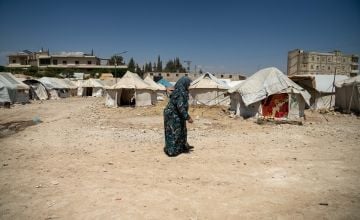
How did it get so bad?
Much like other countries on this list, Syria has spent much of the last century in and out of conflict and political insecurity, which have diminished the ability of civilians to cope with shocks both big and small. The latest cycle began during the country’s Arab Spring protests in 2011, which gave way to an ongoing civil war. The country faced further humanitarian setbacks at the beginning of 2023 when a massive earthquake hit the region.
What we're doing
2. Democratic Republic of Congo
Increased violence in the last few years has added to a series of emergencies that make up the decades-long humanitarian crisis in the Democratic Republic of Congo. Over 27 million Congolese require humanitarian assistance - a number that has gone down compared to last year, but one that remains 35% higher than the estimated humanitarian need in 2022. This has also pushed the DRC into one of the world’s largest food crises. Despite requiring over $3 billion in funding, the UN is only able to target 10.6 million of the 27.3 million Congolese in need of humanitarian assistance, leaving more than half of those requiring aid in a precarious situation.
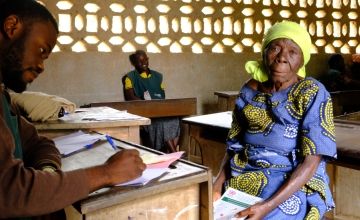
How did it get so bad?
Like other countries on this list, the recent history of the DRC has seen oppression, neglect, and unrest. The country suffered especially under Belgian colonial rule in the 19th Century and was set up for failure when it gained independence in 1960. Even with peace officially declared, the violence has not gone away. Outbreaks of armed conflict have been triggered by land, natural resources, and ethnic disputes.
What we're doing
Concern began working in the DRC when it was still known as Zaire. Since the late 1990s, we’ve focused much of our efforts on long-term development, building schools and health centres, training teachers and health volunteers, and supporting agriculture and livelihood projects. We’ve also led efforts to roll out new water and sanitation infrastructures, especially in provinces that have struggled to recover from two civil wars.
3. Sudan

Despite the iconic images that came out of 2019’s protests, the crisis in Sudan has only gotten worse since promises of reform. More than four years later, however, instability remained a fact of life, with localised conflict displacing tens of thousands of Sudanese in 2022. Earlier this year, that instability escalated into full conflict. “Everything has been lost,” Concern nutrition officer Ahmed Yassin Mohamed Babiker said in October. Humanitarian need has almost doubled within the last year, with 28.1 Sudanese in need of humanitarian assistance. That’s more than half the country’s population.
How did it get so bad?
Many news outlets followed Sudan in the headlines back in 2019, when months of civilian protest led to a transitional government. Slowed progress on this front left room for uncertainty and violence which, since April 15, 2023, has spread across Sudan with major episodes in all states where Concern works - including West and South Kordofan, and West Darfur states.
What we're doing
Despite temporary closures due to the violence, Concern has been responding to the conflict in Sudan. In the first few months of conflict, we reached 42,500 people in South and West Kordofan with life-saving healthcare. Our team in West Darfur successfully moved ten tonnes of medical supplies to equip health centres with vital medicines, vaccines, equipment, and PPE. We are also expanding our health and nutrition programmes to the Red Sea state, operating two mobile clinics with the aim of reaching 35,000 people with vital medical support.
4. Afghanistan

Afghanistan has been caught in conflict since 1978, meaning that three generations of Afghans have never known life without conflict and political instability. The current humanitarian situation in Afghanistan has left 30.6 million Afghans in need of humanitarian assistance, with the UN targeting 24.7 million for assistance in the year ahead.
How did it get so bad?
Conflict stresses a nation’s infrastructure and economy. After 46 years of conflict, those stresses become greater than the sum of their parts. The economic impacts of conflict and crisis have left job opportunities low and debts high, leaving families in even more compromised situations following events like the June 2022 earthquake - the deadliest on record since 1998.
What we're doing
Concern first entered Afghanistan in 1998 following its last major earthquake, and we’ve been there ever since. Since 2020, we’ve been the UN's chosen partner for the emergency response to displacement in the northeastern area of the country. We are also an implementing partner of the Citizen’s Charter Afghanistan Project to help improve local infrastructure, especially to benefit socially-marginalised groups.
5. Ethiopia
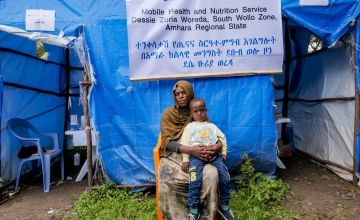
While some rains came to the Horn of Africa in 2023 and hostilities in Ethiopia ceased in late 2022, the country still faces several overlapping and interconnected humanitarian emergencies brought on by the lingering effects of conflict, ongoing climate change, disease (including an unprecedented cholera outbreak), economic issues, and hunger. 20 million Ethiopians require humanitarian assistance, of whom the UN has targeted 14 million for aid in 2024 with a budget of $2.88 billion.
How did it get so bad?
“The progress Ethiopia made is remarkable,” economist Tewodros Makonnen told The New Humanitarian earlier this year. “There is no other comparison in Africa in terms of poverty reduction.” The country had cut its poverty rates from 69% to 27% between 1995 and 2015, and saw an average economic growth of 9.5% each year until 2019. Government initiatives also offered a growing social safety net for citizens, including farmers affected by the shifts of climate change.
In 2020, however, the country saw both the impacts of the COVID-19 pandemic and conflict in the Tigray region, which led to an escalation of already-increasing national inflation rates. In 2016, the Ethiopian inflation rate was 6.6%. By 2017, it was at 10.7%, and in 2020 it had nearly doubled to 20.4%. Last year, it was at nearly 34%. This has led to millions of Ethiopians, many of whom have been displaced, unable to cope.
What we're doing
Concern has worked in Ethiopia for 50 years. Last year, we responded to 19 emergencies in the country, reaching nearly 800,000 people. Reflecting the impact of conflict and drought, our responses focused on food, health, clean water & sanitation, and cash assistance.
Through the Enhanced Response to Nutrition Emergency (ERNE) programme, we also responded to conflict-driven displacement in the Amhara region, providing direct cash assistance to internally-displaced Ethiopians and strengthening local health systems to be better able to identify and treat malnutrition in children. Funded by the EU, ERNE ultimately reached nearly a quarter of a million people between 2021 and 2023.
6. Yemen
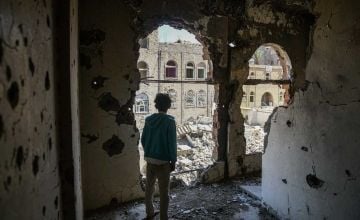
According to UN estimates, the Yemeni Civil War has left nearly 80% of the country’s population in need of some form of assistance. Fighting has also severely damaged food systems, local infrastructure, the economy, and education prospects. 18.2 million people require humanitarian assistance; of whom the UN has targeted 11.2 million for relief in 2024 with a proposed budget of $2.8 billion.
How did it get so bad?
Violence in Yemen escalated sharply in March 2015, escalating unemployment, food insecurity, and insecurity for civilians. The destabilising effects of this conflict has also made it that much harder to get humanitarian aid into the country.
What we're doing
In Yemen, Concern has previously partnered with fellow NGO ACTED (Agency for Technical Cooperation and Development) to design a programme that focused on providing water, sanitation, and hygiene (WASH) services - along with some economic support to help with immediate needs. This year, we returned to the country to build up programming designed to meet ongoing critical needs.
7. Ukraine

On February 24, 2022, a long-simmering crisis in Ukraine escalated into violence with devastating impact. By mid-March, it became the site of one of the world’s largest refugee crises. As this renewed conflict passes the two-year mark, it’s also facing ongoing electricity and fuel shortages. UNOCHA estimates that 16.8 Ukrainians require humanitarian assistance.
How did it get so bad?
Armed conflict began in Crimea in 2014, leaving people in Ukraine’s Donetsk and Luhansk regions facing a decade of insecurity (compounded by the COVID-19 pandemic). Since 2022, that has spread, particularly in the country’s eastern oblasts, or districts, leaving many people displaced by war without a steady income and facing massive inflation rates.
What we're doing
Concern began responding immediately to the crisis in Ukraine, partnering with German NGO Welthungerhilfe and Italian organisation Cesvi to operate a joint emergency response within the country, including some of the eastern cities that have become the temporary homes for many Ukrainians displaced by fighting. We’ve supported special winter centres to provide heat, food, and charging points in areas where electricity has been affected, and also work with local partners to deliver cash transfers and psychosocial support to Ukrainians of all ages.
8. South Sudan

Since gaining independence in 2011, South Sudan has faced constant turbulence and violence, with needs increasing due to climate change, hunger, and public health challenges. After failed peace deals, promised transitional government arrangements and elections have been delayed by years, and aren’t estimated to be put into place until late 2024.
Meanwhile, 13.6 million South Sudanese - at home and displaced abroad - require some form of humanitarian assistance. Within the country, it’s estimated that this need is experienced by 90% of all civilians.
How did it get so bad?
Even before South Sudan was a country, the region (originally part of Sudan) was the site of localised conflict that had eroded local infrastructure and social safety nets. You can learn more about the history of South Sudan - and how we got to this point in the crisis - in our timeline.
What we're doing
Concern has been with South Sudan since day one of the country’s young history. Last year, we reached 430,000 people through health and nutrition, livelihoods, WASH, food security, and shelter programmes. We support 49 health facilities to deliver lifesaving interventions and work with communities to implement integrated Community Case Management (iCCM) of malaria, pneumonia, and diarrhoea, as well as our award-winning Community Management of Acute Malnutrition (CMAM) programmes.
Concern’s emergency response to humanitarian crises
Emergency response is part of Concern’s DNA. Last year alone, Concern responded to 76 emergencies in 23 countries, reaching 16.4 million people. Not each of these emergencies was a full humanitarian crisis, but many of them represent smaller shocks that set many people further and further behind in the middle of a larger crisis. In each context our goal remains the same: fulfil our humanitarian mandate.
When an emergency strikes, we seek out the most vulnerable and hardest-to-reach communities to meet their immediate needs, and work with them to design innovative, fast and effective responses. We stay with them to help rebuild their lives and to ensure that they are better able to cope with future crises. Your support allows us to do this vital work.


